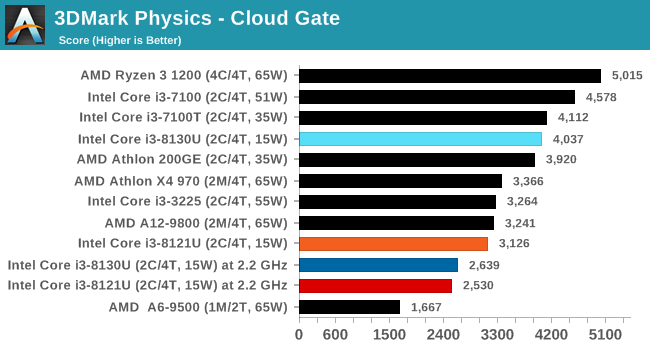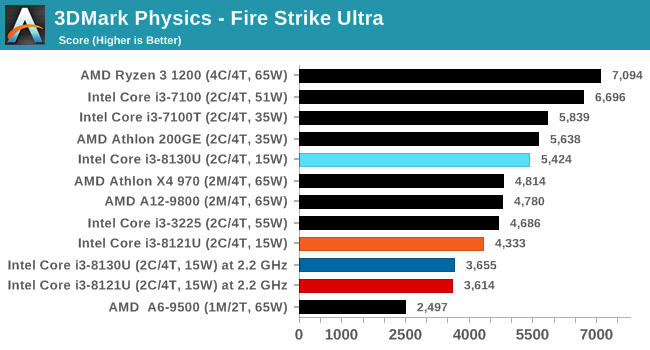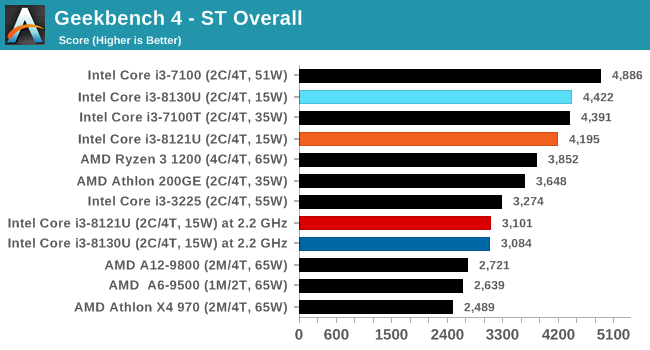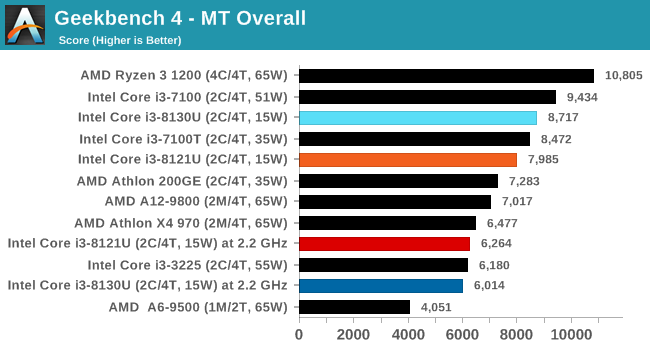Intel's 10nm Cannon Lake and Core i3-8121U Deep Dive Review
by Ian Cutress on January 25, 2019 10:30 AM ESTStock CPU Performance: Office Tests
The Office test suite is designed to focus around more industry standard tests that focus on office workflows, system meetings, some synthetics, but we also bundle compiler performance in with this section. For users that have to evaluate hardware in general, these are usually the benchmarks that most consider.
All of our benchmark results can also be found in our benchmark engine, Bench.
3DMark Physics: In-Game Physics Compute
Alongside PCMark is 3DMark, Futuremark’s (UL’s) gaming test suite. Each gaming tests consists of one or two GPU heavy scenes, along with a physics test that is indicative of when the test was written and the platform it is aimed at. The main overriding tests, in order of complexity, are Ice Storm, Cloud Gate, Sky Diver, Fire Strike, and Time Spy.
Some of the subtests offer variants, such as Ice Storm Unlimited, which is aimed at mobile platforms with an off-screen rendering, or Fire Strike Ultra which is aimed at high-end 4K systems with lots of the added features turned on. Time Spy also currently has an AVX-512 mode (which we may be using in the future).
For our tests, we report in Bench the results from every physics test, but for the sake of the review we keep it to the most demanding of each scene: Ice Storm Unlimited, Cloud Gate, Sky Diver, Fire Strike Ultra, and Time Spy.





In all tests, at fixed frequency, the processors act identical, however at stock frequencies that Kaby Lake chip just has more headroom to push.
GeekBench4: Synthetics
A common tool for cross-platform testing between mobile, PC, and Mac, GeekBench 4 is an ultimate exercise in synthetic testing across a range of algorithms looking for peak throughput. Tests include encryption, compression, fast Fourier transform, memory operations, n-body physics, matrix operations, histogram manipulation, and HTML parsing.
I’m including this test due to popular demand, although the results do come across as overly synthetic, and a lot of users often put a lot of weight behind the test due to the fact that it is compiled across different platforms (although with different compilers).
We record the main subtest scores (Crypto, Integer, Floating Point, Memory) in our benchmark database, but for the review we post the overall single and multi-threaded results.












129 Comments
View All Comments
qcmadness - Saturday, January 26, 2019 - link
I am more curious on the manufacturing node. Zen (14 / 12nm from GF) has 12 metal layers. Cannon Lake has 13 metal layers, with 3 quad-patterning and 2 dual patterning. How would these impact the yield and manufacturing time of production? I think the 3 quad-patterning process will hurt Intel in the long run.KOneJ - Sunday, January 27, 2019 - link
More short-run I would say actually. EUV is coming to simplify and homogenize matters. This is a patch job. Unfortunately, PL analysis and comparison is not an apples-to-apples issue as there are so many facets to implementation in various design stages. A broader perspective that encompasses the overall aspects and characteristics is more relevant IMHO. It's like comparing a high-pressure FI SOHC motor with a totally unrelated low-pressure FI electrically-spooling DOHC motor of similar displacement. While arguing minutiae about design choices is interesting to satisfy academic curiosity, it's ultimately the reliability, power-curve and efficiency that people care about. Processors are much the same. As a side note, I think it's the attention to all these facets and stages that has given Jim Keller such consistent success. Intel's shaping up for a promising long-term. The only question there is where RISC designs and AMD will be when the time comes. HSA is coming, but it will be difficult due to the inherent programming challenges. Am curious to see where things are in ten or fifteen years.eastcoast_pete - Sunday, January 27, 2019 - link
Good point and question! With the GPU functions apparently simply not compatible with Intel's 10 nm process, does anyone here know if any GPUs out there that use quad-patterning at all?anonomouse - Sunday, January 27, 2019 - link
@Ian or @Andrei Is dealII missing from the spec2006fp results table for some reason? Is this just a typo/oversight, or is there some reason it's being omitted?KOneJ - Sunday, January 27, 2019 - link
Great write up, but isn't this backwards on the third page?"a 2-input NAND logic cell is much smaller than a complex scan flip-flop logic cell"
"90.78 MTr/mm^2 for NAND2 gates and 115.74 MTr/mm^2 for Scan Flip Flops"
NAND cell is smaller than flip-flop cell, but there is more flip-flop than NAND in a square millimeter?
Or am I missing something?
Rudde - Sunday, January 27, 2019 - link
A NAND logic cell consists of 2 transistors, while a Scan flip flop logic cell can consist of different count of transistors depending on where it is used. If I remeber correctly, Intel uses 8, 10 and 12 transistor designs.That gives 45.39 million NAND cells per mm² (basically SRAM) and ~12 million flip-flop cells.
The NAND cell is smaller because it consists of fewer transistors.
KOneJ - Sunday, January 27, 2019 - link
It would be great if you guys could get a CNL sample in the hands of Agner Fog. He might be able to answer some of the micro-architecture questions through his tests.dragosmp - Sunday, January 27, 2019 - link
Awesome review, great in depth content and well explained. Considering the amount of work this entailed, it's clear why these reviews don't happen every day. Thanksdragosmp - Sunday, January 27, 2019 - link
I'll just add...many folks are saying AMD should kick arse. They should, but Intel has been in this situation before - they had messed up the 90nm process; probably not quite as bad as the chips to be unusable, but it opened the door to AMD and its Athlon 64. What did AMD do? Messed it up in turn with slow development and poor design choices. Hopefully they'll capitalize this time so that we get an actual dupoloy, rather than the monopoly on performance we had since Intel's 65nm chips.eva02langley - Sunday, January 27, 2019 - link
Euh... You mean this...?https://www.youtube.com/watch?v=osSMJRyxG0k
Anti-competitive tactics? They bought the OEM support to prevent competition.
And, all lately, this came up...
https://www.tomshardware.com/news/msi-ceo-intervie...
"Relationship with Intel: Chiang told us that, given Intel's strong support during the shortage, it would be awkward to tell Intel if he chose to come out with an AMD-powered product. "It's very hard for us to tell them 'hey, we don't want to use 100 percent Intel,' because they give us very good support," he said. He did not, however, make any claims that Intel had pressured him or the company."
Yeah right, Intel is winning because they have better tech... /sarcasm